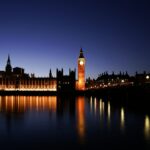The Roswell UFO incident is one of the most famous and controversial events in the history of ufology. It refers to an alleged crash of an unidentified flying object (UFO) near Roswell, New Mexico in July 1947. The incident has captured the imagination of people around the world and continues to be a topic of interest and debate today.
On July 8, 1947, a local rancher named Mac Brazel discovered debris scattered across his property. The debris consisted of metallic fragments, rubber strips, and paper-like material. Brazel reported his findings to the local sheriff, who in turn contacted the nearby Roswell Army Air Field. The military personnel who arrived at the scene quickly determined that the debris was not from a conventional aircraft, leading to speculation that it may have been from an extraterrestrial spacecraft.
The incident gained widespread attention when the Roswell Daily Record published an article with the headline “RAAF Captures Flying Saucer On Ranch in Roswell Region.” However, just a day later, the military issued a statement claiming that the debris was actually from a weather balloon. This explanation was met with skepticism by many, and conspiracy theories began to emerge.
Key Takeaways
- The Roswell UFO incident refers to an alleged crash of an extraterrestrial spacecraft in Roswell, New Mexico in 1947.
- The initial reports of the incident were conflicting and unclear, leading to speculation and conspiracy theories.
- The government’s response to the incident was to deny any involvement and claim that it was a weather balloon that crashed.
- The Roswell incident has had a significant impact on pop culture, inspiring movies, TV shows, and books.
- Despite numerous eyewitness accounts and scientific evidence, many myths and conspiracy theories surrounding the incident have been debunked.
The History of the Roswell Incident
To understand the full context of the Roswell incident, it is important to examine the timeline of events leading up to and following the incident. In June 1947, Kenneth Arnold reported seeing nine high-speed objects flying in formation near Mount Rainier in Washington state. This sighting is often credited with sparking widespread interest in UFOs.
Less than a month later, on July 2, 1947, an alleged UFO crash occurred near Roswell. The military’s initial statement that it was a weather balloon was met with suspicion by many who believed that they were covering up evidence of extraterrestrial life. In the years following the incident, various witnesses came forward with claims of seeing alien bodies and being involved in a government cover-up.
One of the key players in the Roswell incident was Major Jesse Marcel, an intelligence officer at the Roswell Army Air Field. Marcel was one of the first military personnel to arrive at the crash site and was responsible for collecting and transporting the debris. He later claimed that the material he handled was not from a weather balloon, but rather from an extraterrestrial spacecraft. Marcel’s testimony has been central to many of the conspiracy theories surrounding the incident.
The Initial Reports: What Really Happened?
The initial reports from witnesses at the scene of the Roswell incident paint a picture of a crashed UFO and recovered alien bodies. According to some accounts, military personnel were seen removing debris and bodies from the crash site and transporting them to a nearby hangar. Witnesses claimed that the bodies were small, with large heads and eyes, and lacked any discernible human features.
However, there are conflicting accounts and discrepancies in these reports. Some witnesses have come forward to claim that they were coerced into providing false testimony or that their accounts were distorted over time. Skeptics argue that these discrepancies undermine the credibility of the entire incident and suggest that it was nothing more than a case of misidentified or misunderstood phenomena.
The Government’s Response to the Incident
| Response Measure | Effectiveness | Timeline |
|---|---|---|
| Emergency Services Deployment | Effective | Immediate |
| Evacuation Plan Execution | Effective | Timely |
| Communication with Public | Inadequate | Delayed |
| Investigation and Accountability | Ongoing | Long-term |
The government’s initial response to the Roswell incident was to dismiss it as a case of mistaken identity. They claimed that the debris found at the crash site was from a weather balloon used in a top-secret project called Project Mogul, which aimed to detect Soviet nuclear tests using high-altitude balloons.
However, this explanation did little to quell public interest in the incident. Over the years, various government officials have come forward with conflicting statements about what really happened at Roswell. In 1994, the U.S. Air Force released a report titled “The Roswell Report: Case Closed,” in which they concluded that the debris was indeed from a weather balloon and that there was no evidence of extraterrestrial life.
However, this report did little to convince skeptics, who argue that it was merely an attempt to cover up the truth. In 1997, the U.S. General Accounting Office conducted an investigation into the incident and concluded that the military’s initial explanation was plausible. Despite these official statements, the Roswell incident continues to be a subject of speculation and conspiracy theories.
The Roswell UFO Conspiracy Theories
The Roswell incident has given rise to numerous conspiracy theories, each offering a different explanation for what really happened. One popular theory is that the crash was indeed a UFO and that the government covered it up to prevent widespread panic. According to this theory, the bodies recovered from the crash site were not human but extraterrestrial in nature.
Another theory suggests that the crash was actually a Soviet spy plane or experimental aircraft and that the government used the UFO story as a cover-up. Proponents of this theory argue that the government did not want to reveal their advanced technology to the public or to foreign powers.
Yet another theory suggests that the Roswell incident was a psychological operation (psyop) conducted by the government to test public reaction to the idea of extraterrestrial life. According to this theory, the government intentionally leaked false information about a crashed UFO to gauge public interest and assess potential threats.
The Impact of the Roswell Incident on Pop Culture

The Roswell incident has had a significant impact on popular culture, particularly in the realm of science fiction and ufology. The incident has been portrayed in numerous movies, TV shows, and books, often with dramatic embellishments and fictionalized accounts.
One of the most famous depictions of the Roswell incident is in the 1994 film “Roswell,” directed by Jeremy Kagan. The film tells the story of a government cover-up and features fictionalized versions of real-life characters involved in the incident. The film helped to popularize the Roswell incident and introduced it to a wider audience.
The incident has also been the subject of several TV shows, including the popular series “The X-Files.” In this show, FBI agents Mulder and Scully investigate paranormal phenomena, including UFO sightings and government cover-ups. The Roswell incident is frequently referenced throughout the series and serves as a central plot point in several episodes.
The lasting impact of the Roswell incident on popular culture can be seen in the continued fascination with UFOs and extraterrestrial life. The incident has become synonymous with the idea of government cover-ups and has fueled conspiracy theories for decades.
The Role of Eyewitnesses in the Roswell Incident
Eyewitness testimony has played a crucial role in shaping our understanding of the Roswell incident. Many of the initial reports came from witnesses who claimed to have seen the crash site, handled debris, or encountered alien bodies. These eyewitness accounts have been central to the belief that something otherworldly occurred at Roswell.
However, the reliability of eyewitness testimony is often called into question. Studies have shown that human memory is fallible and can be easily influenced by external factors. Over time, memories can become distorted or embellished, leading to discrepancies in eyewitness accounts.
In the case of the Roswell incident, some witnesses have come forward to admit that their initial accounts were inaccurate or exaggerated. Others claim that they were coerced into providing false testimony by military personnel or government officials. These conflicting accounts have made it difficult to determine what really happened at Roswell and have fueled skepticism among critics.
Debunking the Myths Surrounding the Roswell Incident
The Roswell incident has given rise to numerous myths and misconceptions that continue to persist today. One common myth is that the crash site was immediately cordoned off by the military and that no one was allowed access to the area. In reality, the crash site was not secured until several days after the initial discovery, allowing ample time for witnesses to come forward and for debris to be collected.
Another myth is that the government confiscated all evidence of the incident and that there are no physical remnants of the crash. While it is true that much of the debris was collected and transported to various military facilities, some fragments were left behind and have been analyzed by scientists. These analyses have provided alternative explanations for the debris, such as weather balloons or experimental aircraft.
It is also a common misconception that all witnesses to the Roswell incident have been silenced or threatened by the government. While some witnesses have claimed to have been intimidated or coerced into silence, many others have freely come forward with their accounts and have been interviewed by researchers and journalists.
The Scientific Evidence: What Do We Know?
The scientific evidence surrounding the Roswell incident is limited and often inconclusive. The physical debris recovered from the crash site has been analyzed by various experts, including scientists from the U.S. Air Force and independent researchers. However, these analyses have yielded conflicting results and interpretations.
Some scientists argue that the debris is consistent with materials used in weather balloons or experimental aircraft. They point to the presence of rubber strips, metallic fragments, and paper-like material as evidence of a conventional explanation for the incident.
Others argue that the debris exhibits unusual properties that cannot be easily explained by conventional means. They point to the alleged “memory metal” found at the crash site, which is said to have the ability to return to its original shape after being deformed. These researchers believe that this material could be evidence of advanced technology not of this Earth.
Despite these differing interpretations, there is no consensus among scientists regarding the true nature of the Roswell incident. The limited physical evidence and the lack of access to classified military documents make it difficult to reach definitive conclusions.
The Legacy of the Roswell UFO Incident
The Roswell incident has had a lasting impact on ufology and conspiracy theories. It has become one of the most famous and enduring cases in the history of UFO sightings, and its influence can be seen in the continued interest in extraterrestrial life and government cover-ups.
The incident has also sparked a renewed interest in the search for extraterrestrial intelligence (SETI) and has led to increased funding and research in this field. Scientists continue to explore the possibility of life beyond Earth, using advanced telescopes and space probes to search for signs of alien civilizations.
The Roswell incident serves as a cautionary tale about the dangers of misinformation and the power of conspiracy theories. It highlights the need for critical thinking and skepticism when evaluating extraordinary claims. While the truth behind the Roswell incident may never be fully known, it continues to captivate our imagination and inspire us to explore the mysteries of the universe.
FAQs
What is the Roswell UFO incident?
The Roswell UFO incident refers to an event that occurred in 1947 in Roswell, New Mexico, where an unidentified flying object (UFO) crashed on a ranch. The incident has been the subject of much controversy and speculation.
What was the official explanation for the Roswell incident?
The official explanation given by the US military at the time was that the object that crashed was a weather balloon. However, many people believe that this explanation was a cover-up for the true nature of the incident.
What do some people believe really happened during the Roswell incident?
Some people believe that the object that crashed was actually an extraterrestrial spacecraft, and that the US government covered up the incident in order to keep the existence of aliens a secret.
What evidence is there to support the theory that the Roswell incident involved extraterrestrial life?
There is no concrete evidence to support the theory that the Roswell incident involved extraterrestrial life. However, there are many eyewitness accounts and alleged government documents that suggest that the incident was not simply a weather balloon crash.
What impact has the Roswell incident had on popular culture?
The Roswell incident has had a significant impact on popular culture, and has become a widely recognized symbol of the possibility of extraterrestrial life. The incident has been the subject of numerous books, movies, and TV shows, and has inspired countless conspiracy theories.







